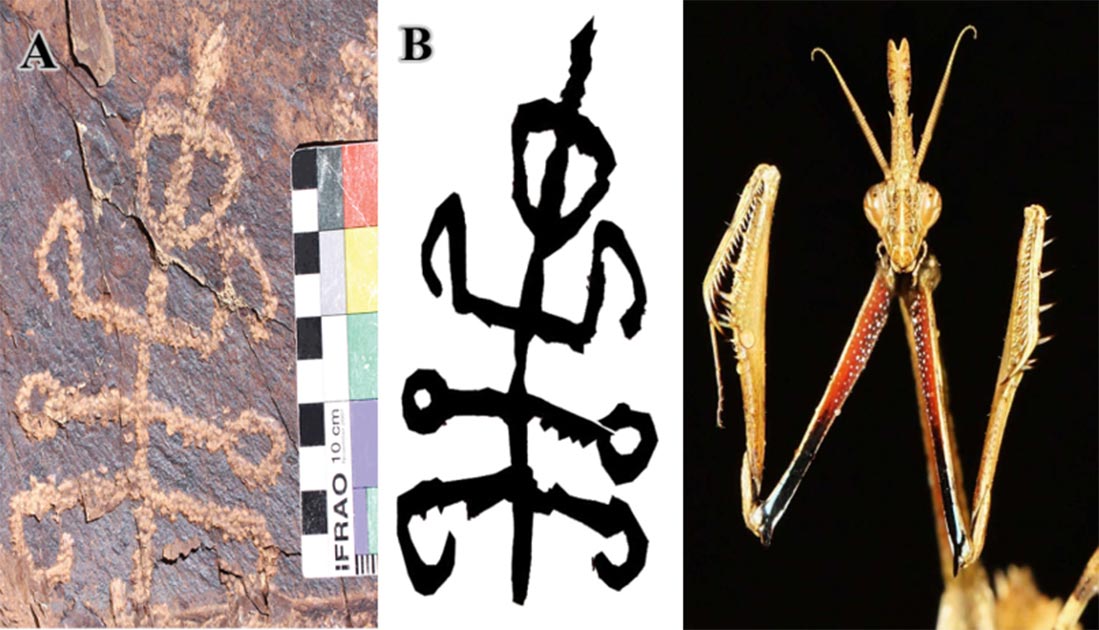Iranian Petroglyph Study: Human-Mantis or Plasma Burst?
A unique six limbed-rock carving has been identified in Central Iran as part human, part mantis, but other much more controversial theories exist.
The Teymareh rock art site contains the country’s earliest known petroglyphs although there are pictographs found in the Yafteh cave, near Sorkheh Lizeh in Lorestan Province, that date back to 40,000 years ago. Even with such a deep historical heritage, petroglyphs showing invertebrate animals are very rare, and that is why archaeologists teamed up with entomologists to identify this particular motif.
The Mystical and Supernatural Mantis
A new paper about the “half mantis, half human” figure has been published in the open access Journal of Orthoptera Research by a team of international entomologists from Iran and Taiwan, including: Mahmood Kolnegari from Iran’s Islamic Azad University of Arak; Mandana Hazrati of the Avaye Dornaye Khakestari Institute; Mohammad Naserifard, an Iranian freelance archaeologist and rock art specialist, and Matan Shelomi from the National Taiwan University.
While the figure's six limbs suggest it’s an insect, its forearms resemble those of a predatory praying mantid (mantis), and this idea is supported by the triangular shaped head and bulging eyes: and it was these features that led the researchers to associate the ancient carving with “ Empusa hedenborgii,” a genus of mantids native to this region. The researchers wrote that “One can only guess why prehistoric people felt the need to carve a mantis-man into rock,” but it suggests mantids were linked with the supernatural since ancient times, “animals of mysticism and appreciation.”

“Squatting mantis man” petroglyph. A. The inspected petroglyph, located in Teymareh Region, Khomein County, Markazi Province, Iran. IFRAO (International Federation of Rock Art Organizations) Standard Scale: 10 cm from end to end. Photo credit: M. Naserifard. B. Black and white drawing of the motif (illustration by M. Kolnegari). (Journal of Orthoptera Research)
Or Is It A Z-Pinch Plasma Burst, Maybe?
The creature’s middle two limbs have been stylized and end with circles which is a design component found on petroglyphs on every continent of the prehistoric world, most often referred to in archaeology as the “Squatter” or “Stick Man,” and its appearance all over the ancient world suggests it was inspired by the same environmental condition, or event, most often thought of as having occurred in the sky for distant cultures to have witnessed the same thing.
An news release about the Iranian mantis-human figure published on Eureka Alert speculates that the petroglyph showing a figure flanked by circles represent “ auroras caused by atmospheric plasma discharges.” The leader of this archaeological interpretation is Dr. Anthony L. Peratt, a leading American plasma physicist, who in his 2003 paper titled "Characteristics for the Occurrence of a High-Current, Z-Pinch Aurora as Recorded in Antiquity" said this type of image in ancient rock art represented “ Plamsa Discharge” witnessed by humans from Australia to America, leading to the creation of the six-limbed “Squatting Man.”
![Sarkubeh village [Markazi province], the closest human habitation to the petroglyph site. (Mr Mahmood Kolnegari / CC BY 4.0)](https://www.ancient-origins.net/sites/default/files/styles/large/public/Sarkubeh.jpg?itok=sB7aJB5z)
Sarkubeh village [Markazi province], the closest human habitation to the petroglyph site. (Mr Mahmood Kolnegari / CC BY 4.0)
Nuclear Sanctions Forced Broad Dating Brackets
In the newly published paper about the Iranian carving the scientists say is presently impossible to date it because nuclear sanctions on Iran prohibit its use of the radioactive materials needed for radiocarbon dating, but petroglyph experts Jan Brouwer and Gus van Veen from The Netherlands estimated the carvings were made “ 40,000-4,000 years ago.” You will perhaps notice that this estimated date bracket is the scientific version of you or I saying “we don’t have a Scooby,” wherein “Scooby” is short for “Scooby-doo,” representing the word “clue.”
Without access to nuclear processing equipment the scientists are at a loss trying to date the petroglyph, because stone petroglyphs don’t hold organic matter, having been carved into rock rather than having been painted. However, it might be the case that the mantis-human, represented, a major plasma discharge event and if this is the case perhaps we can tighten in on the date of the Iran petroglyph by comparing it with similar examples that have been dated.
Might Comparative Analysis Help Date The Petroglyph?
El Abra, is an extensive archeological site located east of the municipality Zipaquirá in the Cundinamarca department of Colombia, and this extensive series of rock shelter and cave system was the focus of a late 1960s study by a team of researchers from the Indiana University. Studying the stratigraphy of lithic tools, and radiocarbon dated bones and vegetal charcoal, the scientists established that the site was inhabited by hunter-gatherers of the Late Pleistocene epoch between “12,400 ± 160 years BP” (10,400 BC) one of the first evidences of human settlement in the Americas.
Among the petroglyphs at El Abra is a six-limbed “Squatting-man,” and archaeologists know this site was abandoned by 8,000 BC. Thus, if the petroglyphs in Colombia and Iran do indeed depict the same plasma discharge event in the sky, as Dr. Peratt suggested, then the Iran carving was created somewhere between 10,400 and 8,000 BC. But as I said, this is speculation in its purest form.

El Abra, petroglyph of the six-limbed Squatting-man design. (Public Domain)
The study ‘Squatting (squatter) mantis man: A prehistoric praying mantis petroglyph in Iran’ by Mohammad Kolnegari et al is published in the Journal of Orthoptera Journal of Orthoptera Research 29(1): 41-44. https://doi.org/10.3897/jor.29.39400.
Top image: The Squatter / Mantis-Man petroglyph found in Teymareh rock art site, Iran. Right A praying mantis, Empusa hedenborgi. Source: Dr Mohammad Naserifard / Mr Mahmood Kolnegari
By Ashley Cowie
Resources
Kolnegari M, Naserifard M, Hazrati M, Shelomi M (2020) Squatting (squatter) mantis man: A prehistoric praying mantis petroglyph in Iran. Journal of Orthoptera Research 29(1): 41-44. https://doi.org/10.3897/jor.29.39400




















Comments
I'm surprised to see anyone here write about this. This page gives a little more info: http://www.theplasmaverse.com/verse/squatterman-plasmadischarges-petrogl...
and more in depth discussion can be found at thunderbolts.info.